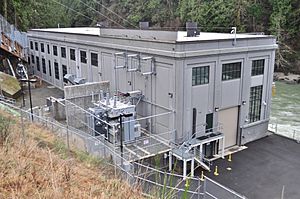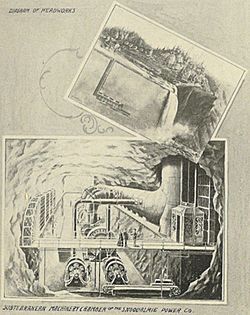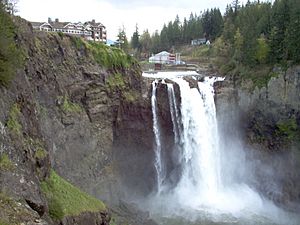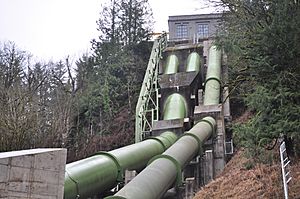Snoqualmie Falls Hydroelectric Plant facts for kids
Quick facts for kids Snoqualmie Falls Hydroelectric Plant |
|
|---|---|

Plant 2 along the Snoqualmie River
|
|
| Country | United States |
| Location | Snoqualmie, Washington |
| Coordinates | 47°32′39.50″N 121°50′29.27″W / 47.5443056°N 121.8414639°W |
| Status | Operational |
| Construction began | Plant 1: 1898 Plant 2: 1956 |
| Commission date | Plant 1: 1899/1905 Plant 2: 1910 Upgrade: 2013 |
| Owner(s) | Puget Sound Energy |
|
Snoqualmie Falls Cavity Generating Station
|
|

Cutaway diagrams of the plant
|
|
| Location | King County, Washington |
| Nearest city | Snoqualmie, Washington |
| Built | 1899 |
| Architect | Charles H. Baker |
| NRHP reference No. | 76001895 |
| Added to NRHP | April 23, 1976 |
The Snoqualmie Falls Hydroelectric Plant is a special power station in King County, Washington, USA. It's located just north of the town of Snoqualmie. This plant is about 22 miles (35 km) east of Seattle.
The power plant sits right below the amazing Snoqualmie Falls. It has two main parts: Plant 1 and Plant 2.
- Plant 1 was finished in 1899. It's unique because it's completely underground. It was the first underground hydroelectric power plant ever built in the world!
- Plant 2 was built later, in 1910. It's located next to the Snoqualmie River.
Both plants get their water from a small lake created by a weir (a low dam) at the top of the falls. Together, Plant 1 and Plant 2 can produce 53.9 megawatts (MW) of electricity. This is enough power for about 40,000 homes!
Plant 1 is very important historically. It was added to the National Register of Historic Places in 1976. In 1981, it was also named a Historic Civil Engineering Landmark by the American Society of Civil Engineers. The entire power plant area was added to the National Register of Historic Places in 1992. The plant is owned by Puget Sound Energy.
Contents
Building the Power Plant
The idea for this power plant came from an engineer named Charles H. Baker in the 1890s. He often saw the Snoqualmie Falls during his work. Baker wanted to use the power of the falling water to make electricity, just like at Schoellkopf Power Station near Niagara Falls in New York.
After losing his job, Baker decided to build the plant. His family helped him with money. In 1897, he started the Snoqualmie Falls Power Company and bought the land around the falls.
- Construction began in 1898.
- Workers first built a temporary dam called a cofferdam. This kept the river water away from where they needed to work.
- They used steam-powered drills to dig a deep vertical shaft from the water intake down to the underground cavern for Plant 1.
- They also dug a horizontal tunnel that met the vertical shaft.
- A weir was built above the falls to raise the river level. This helped water flow into the plant.
Initially, four Pelton turbines were installed in Plant 1. Each had a 1.5 MW Westinghouse generator.
- The first generator started making power for Seattle on July 31, 1899.
- By November 1, 1899, all generators were working and sending power to Tacoma too.
In 1905, a fifth, more powerful turbine was added to Plant 1. It was a 5 MW Francis turbine. Later, in 1908, Puget Sound Energy took over the plant.
Expanding the Power Plant
Soon after the fifth generator was added to Plant 1, plans for Plant 2 began. Engineer W.A. Brackenridge designed it.
- Plant 2 would get water through a tunnel from the weir, leading to a forebay. A forebay is like a holding pond for water before it goes into the turbines.
- Plant 2 started working in 1910 with one 9 MW Francis turbine-generator.
- The tunnel and pipes (called penstocks) were built large enough for future expansion.
Plant 2 was expanded starting in 1956.
- A second Francis turbine-generator was installed in 1957.
- A larger second penstock was also added for this new, bigger generator.
- At this time, the entire power plant could produce 44.4 MW of electricity.
Over the years, parts of Plant 2 were replaced to keep it running well. In 2004, Puget Sound Energy got a new license for the plant. This license required the plant to always let at least 30 cubic feet (0.85 cubic meters) of water per second flow downstream.
Upgrades and Improvements
In April 2010, Puget Sound Energy started a big project to improve the power plant. This project cost $200 million!
- They updated the first four generators in Plant 1 and replaced the fifth one.
- A turbine-generator in Plant 2 was also replaced.
- The weir (low dam) was made lower (16 feet or 4.9 meters high) and longer (37 feet or 11 meters). This helps reduce flooding upstream.
- The water intake structure was replaced.
- The penstocks, which carry water to the plants, were also upgraded.
- New automatic shut-off and bypass valves were installed for Plant 2. These valves help in emergencies and allow water to flow downstream if Plant 2 is not working.
The project also included improvements for visitors and tourism. These included new visitor centers, hiking trails, and a boardwalk. The renovations on Plant 2 were finished in April 2013. The new 6.5 MW Francis turbine generator in Plant 1 and the whole project were completed in mid-2014. These upgrades increased the plant's total power output from 44.4 MW to 53.9 MW.
How the Plant Works
The Snoqualmie Falls Hydroelectric Plant uses the power of falling water to make electricity.
- A weir (low dam) creates a small reservoir (lake) at the top of the falls. The weir is between 4 and 16 feet (1.2 and 4.9 meters) high.
Plant 1 Design
- Water for Plant 1 enters an intake near the left side of the weir.
- It then flows down a 280-foot (85-meter) long, 7-foot (2.1-meter) wide vertical penstock (a large pipe).
- Plant 1 is located in a huge underground cavern. This cavern is 270 feet (82 meters) below the ground and about 300 feet (91 meters) behind the falls.
- The cavern itself is 200 feet (61 meters) long, 40 feet (12 meters) wide, and 30 feet (9.1 meters) high.
- Inside, there are four 1.8 MW Pelton turbine-generators and one 6.5 MW Francis turbine-generator.
- After the water passes through the turbines, it flows out through a 650-foot (200-meter) long tunnel. This tunnel returns the water to the river below the falls.
Plant 2 Design
- The intake for Plant 2 is near the right side of the weir.
- Water first goes into a tunnel that runs along a ridge next to the river.
- It reaches a forebay, which holds the water temporarily.
- From the forebay, a gatehouse releases water into two penstocks. These pipes are about 520 feet (160 meters) long. The larger one is 10 feet (3.0 meters) wide.
- The penstocks lead to Plant 2, which is located on the right bank of the Snoqualmie River.
- Plant 2 has a 13.7 MW and a 26.5 MW Francis turbine-generator.
- Water discharged from Plant 2 flows directly back into the river.



